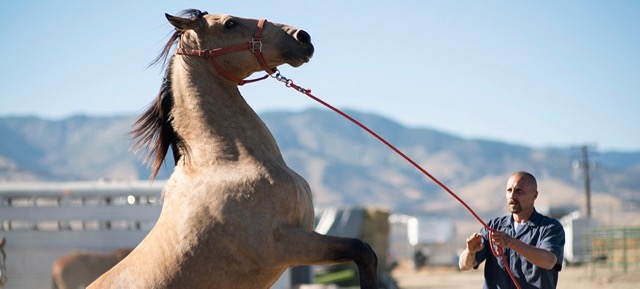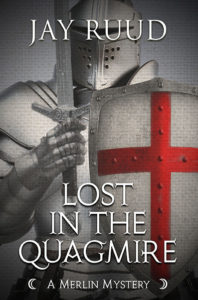The Mustang
Laure de Clermont-Tonnerre (2019)
[av_image src=’http://jayruud.com/wp-content/uploads/2014/12/3-12.jpg’ attachment=313′ attachment_size=’square’ align=’left’ animation=’left-to-right’ link=” target=” styling=” caption=’yes’ font_size=” appearance=’on-hover’]
Three Tennysons/Half Shakespeare[/av_image]
[av_textblock size=” font_color=” color=”]
This is a little gem of a film that might not be on your radar, since it has had virtually no promotion and is in very limited release. But it’s one that is well worth your chasing down if you can. The one screen it’s playing on right now in Central Arkansas is at Riverdale 10, but I’d hurry if you want to see it there, since it’s not likely to be there long.
Laure de Clermont-Tonnerre is a French actress, and American audiences might possibly remember her from 2007’s The Diving Bell and the Butterfly. As a director, this is her first feature-length film, though it is loosely based on her 2014 short Rabbit, a film that made the rounds and won several awards at film festivals. Based in part on the success of that film, de Clermont-Tonnerre received an “emerging talent” grant from Robert Redford’s Sundance Institute film lab to develop her script for The Mustang into a feature film. Redford is listed as executive producer for the project.
The opening scenes of the film present us with gorgeous vistas of public land in the west, where a large herd of mustangs roam wild. But their glorious freedom is interrupted by the grating roar of helicopters that are used to round up the horses and frighten them into holding pens. We are told that the government has removed hundreds of thousands of wild horses over the past few decades from public lands. What the film does not mention specifically is the fact that such roundups kill or maim many horses, and that the horses are removed from public lands and put into small pens because the Bureau of Land Management is acting under pressure from large ranchers who want their cattle to graze on public lands, and from oil companies interested in fracking. This political background is missing from the film, but the images of the penned up wild horses do speak for themselves.
What happens to a handful of these magnificent animals forms the subject matter for this film. Up to 2,000 wild mustangs may be held after these roundups in a holding facility jointly supervised by the Bureau of Land Management and the Nevada Department of Correction-Silver State Industries, and of these some 50 to 75 each year are part of a training program that utilizes prison inmates who spend time—in the film it is five weeks—with the animals, training them and at the end of the process making them available for public adoption, often by law enforcement agencies, particularly officers patrolling the U.S.-Mexico border. The process, of course, is also a rehabilitation exercise for the inmates, who not only feel they are doing something useful, but also form an empathetic bond with the animals they train.
The film, then, becomes a story of redemption for violent inmate Roman Coleman (Matthias Schoenaerts fromFar from the Madding Crowd). Coleman has already served a dozen years for a violent attack on his domestic partner that left her helplessly brain damaged. We learn this by degrees as the movie progresses: At first, we only see Roman with the prison psychologist (Connie Britton from TV’s Dirty John), who is trying to get him to respond to something—anything—that might reveal a preference he would have for a work assignment in what seems to be a new prison for him. She ends up assigning him to “outdoor maintenance,” which at this place consists of disposing of horse manure.
But the crusty, hard-bitten old cowpoke Myles (screen veteran Bruce Dern), who is in charge of the training program, sees something in Roman, and decides to give him a chance to train a particularly cantankerous new mustang arrival who Roman names “Marcus.” Helped along by an infectiously good-humored fellow inmate and experienced trainer named Henry (Jason Mitchell from Straight Outta Compton), Roman makes some halting progress before completely losing his temper and channeling all his frustrations out on the horse, physically attacking Marcus with savage blows to his ribs.
The no-nonsense Myles will have none of this and has Roman thrown into solitary confinement. Roman also goes through anger management classes. Despite his explosion, Myles eventually does let Roman come back to resume training Marcus, and with Henry’s help he actually begins to make some progress. In the meantime, Roman gets a surprise visit from his daughter Martha (Gideon Adlon from Blockers). While he is not exactly welcoming to her, she is the only person he responds to with more than a grunt for the entire first half of the movie. The pregnant Martha, though still a minor, wants his signature on a form that will “emancipate” her so that she can go and live with her boyfriend and have the baby.
As the film progresses and Roman comes to respect the horse, take pride in his own work and form marginally better relationships with Henry, Myles and ultimately Martha as well, we can sense that this human life has value, even if he is never reintegrated into normal human society. And although there are other twists in the story, and an ending we might not have seen coming, nothing is really more important than what we’ve learned to this point. The rest is just plot.
One flaw in that plot is another violent incident Roman is involved in later for which he seems to incur no punishment, a development that left me scratching my head. But overall the script is impressive, and manages to get us to appreciate Roman’s difficult journey and his ongoing redemption without resorting to clichés or sentiment. That in itself is a wondrous achievement.
So is Schoenaerts’ understated performance as he brings to life a character with little redeeming social value, but one who recognizes his crimes and finds something to live for after all. As for Bruce Dern, nobody can play a crusty old hardened tough guy like he can. Most of the other prisoners are actually played by inmates who have themselves been part of this rehabilitation program, and their presence augments the realism of the scenes with the horses and within the prison complex as well.
But another major star of the film is cinematographer Ruben Impens (who recently shot Beautiful Boy). Impens’ images of galloping horses or of sunrise over the desert are often so beautiful it is a shame that the film is in such limited release (it was actually released in mid-March and took a month to get here at all), because that means most of you will only get to see it on streaming video rather than on the big screen, where you can fully enjoy those images.
Kudos to Redford and his Sundance lab that made it possible for this movie to be made. I’m giving it three Tennysons and half a Shakespeare, and urging you to go see it on a movie screen while you still can.
Just named a finalist for the INDIE award for best Mystery novel of the year:
Jay Ruud’s most recent novel, Lost in the Quagmire: The Quest of the Grail, IS NOW a finalist for this year’s INDIE award for books by independent publishers. You can order your copy direct from the publisher (Encircle Press) at http://encirclepub.com/product/lost-in-the-quagmire/You can also order an electronic version from Smashwords at https://www.smashwords.com/books/view/814922
When Sir Galahad arrives in Camelot to fulfill his destiny, the presence of Lancelot’s illegitimate son disturbs Queen Guinevere. But the young knight’s vision of the Holy Grail at Pentecost inspires the entire fellowship of the Round Table to rush off in quest of Christendom’s most holy relic. But as the quest gets under way, Sir Gawain and Sir Ywain are both seriously wounded, and Sir Safer and Sir Ironside are killed by a mysterious White Knight, who claims to impose rules upon the quest. And this is just the beginning. When knight after knight turns up dead or gravely wounded, sometimes at the hands of their fellow knights, Gildas and Merlin begin to suspect some sinister force behind the Grail madness, bent on nothing less than the destruction of Arthur and his table. They begin their own quest: to find the conspirator or conspirators behind the deaths of Arthur’s good knights. Is it the king’s enigmatic sister Morgan la Fay? Could it be Arthur’s own bastard Sir Mordred, hoping to seize the throne for himself? Or is it some darker, older grievance against the king that cries out for vengeance? Before Merlin and Gildas are through, they are destined to lose a number of close comrades, and Gildas finds himself finally forced to prove his worth as a potential knight, facing down an armed and mounted enemy with nothing less than the lives of Merlin and his master Sir Gareth at stake.
Order from Amazon here: https://www.amazon.com/Lost-Quagmire-Quest-Merlin-Mystery/dp/1948338122
Order from Barnes and Noble here: https://www.barnesandnoble.com/w/lost-in-the-quagmire-jay-ruud/1128692499?ean=9781948338127


